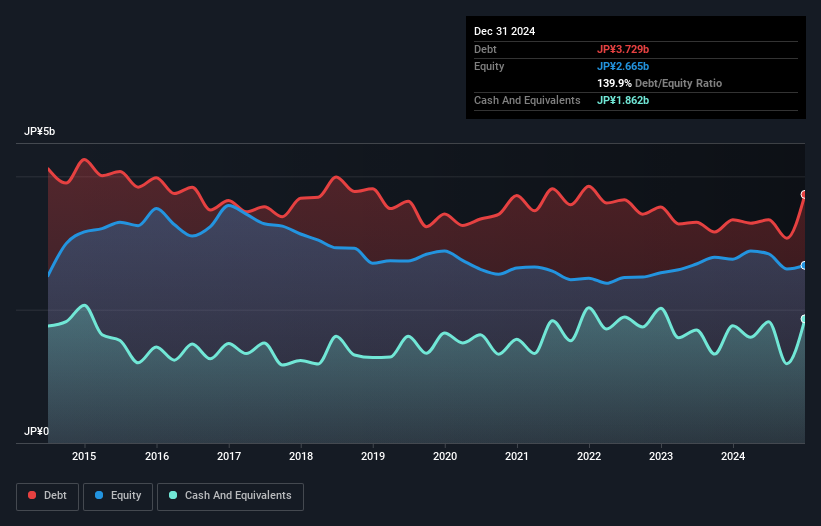
Howard Marks put it nicely when he said that, rather than worrying about share price volatility, 'The possibility of permanent loss is the risk I worry about... and every practical investor I know worries about.' It's only natural to consider a company's balance sheet when you examine how risky it is, since debt is often involved when a business collapses. We can see that The Lead Co., Inc. (TSE:6982) does use debt in its business. But the real question is whether this debt is making the company risky.
Why Does Debt Bring Risk?
Debt is a tool to help businesses grow, but if a business is incapable of paying off its lenders, then it exists at their mercy. In the worst case scenario, a company can go bankrupt if it cannot pay its creditors. While that is not too common, we often do see indebted companies permanently diluting shareholders because lenders force them to raise capital at a distressed price. Of course, debt can be an important tool in businesses, particularly capital heavy businesses. When we examine debt levels, we first consider both cash and debt levels, together.
What Is Lead's Debt?
You can click the graphic below for the historical numbers, but it shows that as of December 2024 Lead had JP¥3.73b of debt, an increase on JP¥3.35b, over one year. On the flip side, it has JP¥1.86b in cash leading to net debt of about JP¥1.87b.

A Look At Lead's Liabilities
According to the last reported balance sheet, Lead had liabilities of JP¥2.62b due within 12 months, and liabilities of JP¥3.01b due beyond 12 months. Offsetting this, it had JP¥1.86b in cash and JP¥735.0m in receivables that were due within 12 months. So its liabilities total JP¥3.04b more than the combination of its cash and short-term receivables.
This deficit casts a shadow over the JP¥1.29b company, like a colossus towering over mere mortals. So we definitely think shareholders need to watch this one closely. After all, Lead would likely require a major re-capitalisation if it had to pay its creditors today. There's no doubt that we learn most about debt from the balance sheet. But you can't view debt in total isolation; since Lead will need earnings to service that debt. So when considering debt, it's definitely worth looking at the earnings trend. Click here for an interactive snapshot .
Check out our latest analysis for Lead
In the last year Lead had a loss before interest and tax, and actually shrunk its revenue by 16%, to JP¥4.3b. That's not what we would hope to see.
Caveat Emptor
Not only did Lead's revenue slip over the last twelve months, but it also produced negative earnings before interest and tax (EBIT). Indeed, it lost a very considerable JP¥153m at the EBIT level. When we look at that alongside the significant liabilities, we're not particularly confident about the company. It would need to improve its operations quickly for us to be interested in it. For example, we would not want to see a repeat of last year's loss of JP¥138m. In the meantime, we consider the stock to be risky. There's no doubt that we learn most about debt from the balance sheet. But ultimately, every company can contain risks that exist outside of the balance sheet. We've identified 2 warning signs with Lead , and understanding them should be part of your investment process.
If you're interested in investing in businesses that can grow profits without the burden of debt, then check out this free list of growing businesses that have net cash on the balance sheet.
New: AI Stock Screener & Alerts
Our new AI Stock Screener scans the market every day to uncover opportunities.
• Dividend Powerhouses (3%+ Yield)
• Undervalued Small Caps with Insider Buying
• High growth Tech and AI Companies
Or build your own from over 50 metrics.
Have feedback on this article? Concerned about the content? Get in touch with us directly. Alternatively, email editorial-team (at) simplywallst.com.
This article by Simply Wall St is general in nature. We provide commentary based on historical data and analyst forecasts only using an unbiased methodology and our articles are not intended to be financial advice. It does not constitute a recommendation to buy or sell any stock, and does not take account of your objectives, or your financial situation. We aim to bring you long-term focused analysis driven by fundamental data. Note that our analysis may not factor in the latest price-sensitive company announcements or qualitative material. Simply Wall St has no position in any stocks mentioned.
About TSE:6982
Lead
Designs, manufactures, and sells automotive parts, and electronic equipment related racks and cases in Japan.
Very low with worrying balance sheet.
Market Insights
Community Narratives



